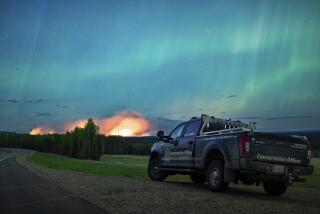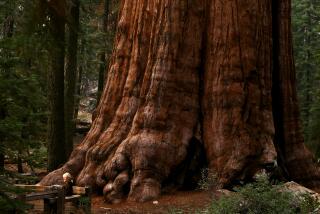Pollution Held to Decimate Trees, Crops
- Share via
WASHINGTON — Air pollution is contributing heavily to the decimation of forests in the nation’s coastal mountain ranges and causing billions of dollars in damage to Midwestern crops, researchers said Thursday in a report urging sharp cutbacks in fossil fuel use.
Unless pollution levels are reduced, crop damage will increase and forest destruction now occurring primarily at high elevations could spread to lower areas and to other tree species, according to a study by the World Resources Institute, a Washington-based environmental research group.
Although scientists have suspected for years that air pollution has played a role in isolated deaths of forests, the study draws a more certain link between airborne contaminants and the vegetation decline that has become more common recently.
Calls Evidence ‘Unambiguous’
James J. MacKenzie, an institute researcher, told a Capitol Hill news conference that the scientific evidence is now “unambiguous” that pollution is contributing to the decline of forests.
Researchers said that two culprits--low-level ozone buildup and highly acidic moisture in clouds--are combining with natural stresses such as heat waves and droughts to cause a plight that is steadily engulfing more and more of the nation’s forests.
“In the West, sensitive pines are dying; throughout the Midwest, crop productivity is being impaired; and, in the East, spruce, fir, maple . . . and pine are either dying outright or growing abnormally slowly,” the report said.
Ozone pollution and acid rain result from high levels of sulfur dioxide, nitrogen oxide and hydrocarbons--common chemicals emitted by fossil fuel-burning factories and automobiles, researchers said.
Parts of Study Disputed
Other air pollution experts disputed parts of the study. Patricia Irving, a senior scientist in the Reagan Administration’s acid rain project, said that, although ozone has been proved to damage trees and crops, there is no conclusive evidence that acid rain is responsible for any damage.
She said there is more evidence that insects, droughts and forest fires have caused more tree damage than either form of pollution.
The institute report cited high concentrations of pollutants in areas of crop and tree damage as evidence that they are responsible for the destruction.
MacKenzie said that along the Appalachian Mountain chain, where the most severe tree damage has been recorded, the average acidity of cloud moisture is 10 times greater than the rain dropped on nearby lower elevations. As clouds pass over mountains, they deposit the highly acidic moisture on vegetation, he said.
High Ozone Levels Found
In addition, he said, high ozone levels are common throughout Midwestern farmlands and in many of the mountainous areas where trees are dying.
Ozone in the upper atmosphere shields the Earth from dangerous solar radiation, but ground-level ozone contributes to smog, respiratory damage to people and damage to trees and crops.
The study said that ozone and acid rain have combined with other factors in recent years to damage 87% of ponderosa and Jeffrey pines in Southern California’s San Bernardino National Forest and kill 60% of high-altitude spruce in Vermont, New Hampshire and New York.
Pollutants are also largely responsible for damage to more than half of the red spruce and Fraser fir trees on Mt. Mitchell, N. C., and increased mortality in the spruce-fir forests of Tennessee and yellow pines throughout the Southeast.
More to Read
Sign up for Essential California
The most important California stories and recommendations in your inbox every morning.
You may occasionally receive promotional content from the Los Angeles Times.









